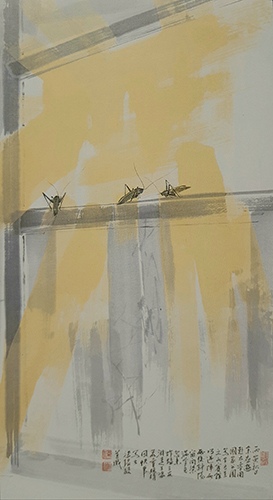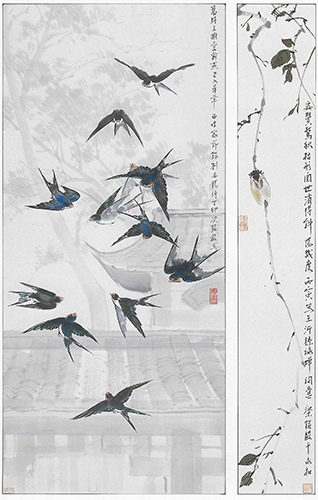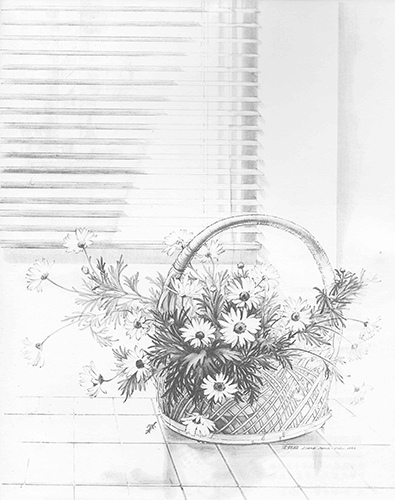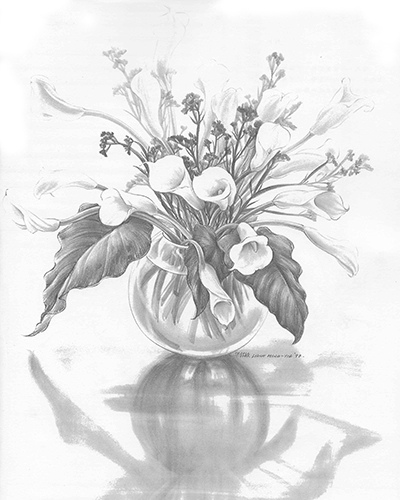Artist Ming-Yi Liang
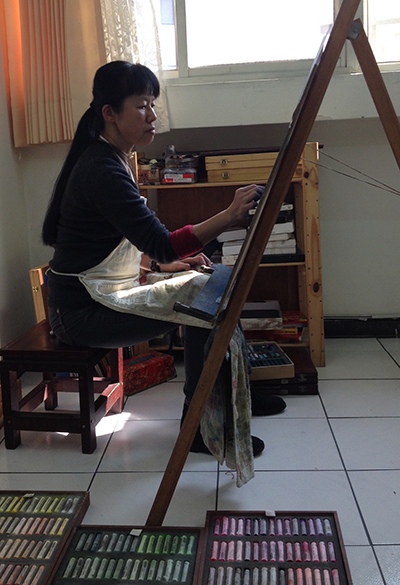
Perseverance in the Making
A skinny artist wearily overburdened with work gave birth to a tiny, premature baby, commencing the third generation of artists in the Liang Family.
Though this little family was not affluent, its shelves were filled with books, and artworks covered the walls. She could hear her father playing the violin when he was not writing poems or painting. Her’s was a world enriched with music and art.
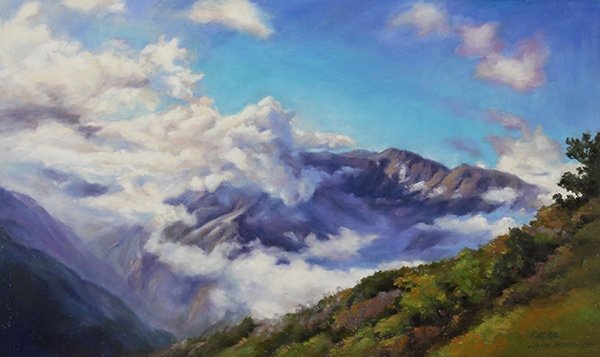
When Ming-Yi was around one year old she drew circles, squares, and crossing lines on the lap of her artist grandfather Ding-Ming Liang, famous for his historic paintings and paintings of horses.
As she grew a little older there were no toys to play with, so she copied what her mother Dan-Fong Liang did and drew with a tiny pencil on paper on the small table and chair her mother made.
When her mother came home with food from the market, it was time for everyone to “borrow” the vegetables and fruits on the table to draw. Afterward, those foods were no longer fresh but could still be cooked for meals.
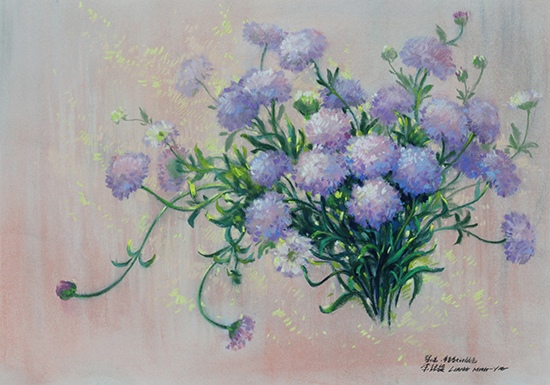
Her artist mother with keen observation, sensitivity to color, and lively inspiration often turned difficult aspects of life into loving memories. She tailored her own clothes into dresses and shirts for her three children. When they lined up they looked as cool as the Trapp children in the movie Sound of Music. The bowknot from a dress can be two little children walking hand-in-hand for a picnic, green plait patterns with white-collar looks like two chatting friends, one tall and one short. Rice in a bowl, when pushed upside down on the plate, became a rice mount ready to form the basis of a face with ketchup for its red hair, a lady with red blush on her cheeks, or even an old man’s beard by adding some veggie leaves…
From these fond memories little Ming-Yi realized even if one can’t afford material enjoyment, a mind with abundant ideas and freedom in thinking can be a wellspring of creation. The union of art and life can transform anything!
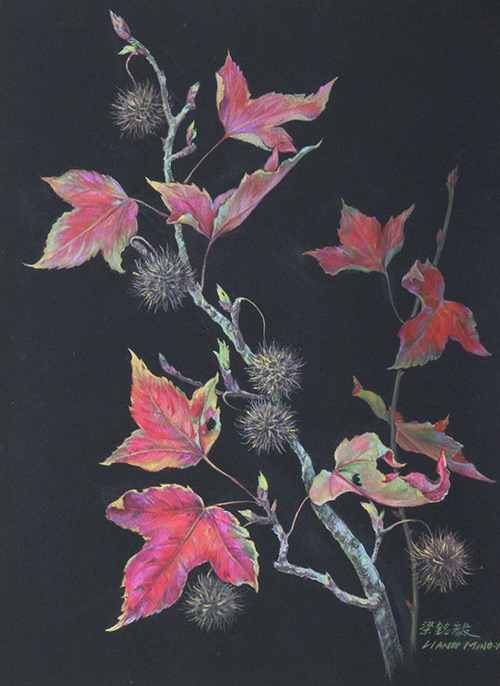
But her life was far from idyllic. Then she witnessed creditors rushing in to take away anything they could from their home when her father went bankrupt. While walking home from school she came upon a construction worker who fell from the scaffolding and died right in front of her. She was constantly humiliated by schoolmates and teachers because of a scar on her cheek. Together with some near-death experiences, she became premature compared to others of similar age in the realization of the impermanence of life and things in the world, and in piercing through hypocrisy and perceiving what’s really behind the masks.
As a firstborn, she understood the difficulties her family had to face. She helped take care of her younger brother and sister, shared household chores, and without caring for herself she never hesitated to take up burdens. She also organized things well and could restore mess to order.
When she learned tailoring in high school the clothes she made looked new. She became skilled at knitting; all those amazing works were accomplished with perseverance, and some are still displayed on her mother’s desk. When she cooked the dishes were not only delicious and pretty to look at, but also capable of artfully varying tastes with ingredients. She even helped set up still lifes in the studio with daring combinations of bright colors that look happy together.
Of course, she’s been through a childhood not unlike that of many others. Once she threw her fists at those that taunted her, and was seriously scolded by her mother and had to kneel for a while so as to reflect and regret the misdeeds she made. She’d also been a stubborn, embarrassing teenager, but her mother tried to direct her unbending spirit by focusing her mind on what she was learning.
If her mother had to face all kinds of challenges with unyielding steadfastness for the family to survive, Ming-Yi learned not to rely on luck but to put in more effort than most others if only to reap one-tenth of the harvest. It is with such stubborn effort that she was able to persevere through the more turbulent times and those yet to come.
It seemed the more turmoil she faced and persisted through, the more challenges she had yet to overcome, resulting in her developing stronger and stronger patience. Meanwhile, youthful bitterness and anger gradually turned into understanding, an open mind, and as a result, she could calmly face endless tests of fate.
She loves sports and joins hiking tours with heavy backpacks climbing mountains. In this way, her body was strong like her mind, making it easier for her to face challenges.
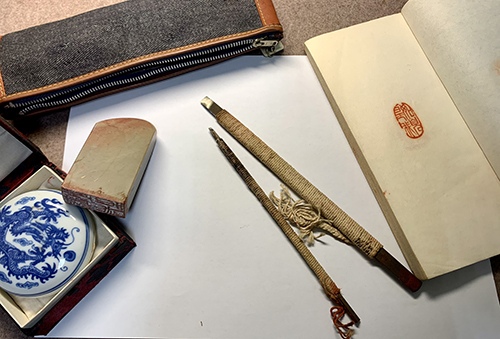
After high school, Ming-Yi wanted to major in art. Her mother knew it to be a difficult path but she did not consider it proper to disagree.
In 1974 Ming-Yi was accepted to National Taiwan University of Arts, majoring in Chinese and Western painting, and also studied seal carving and calligraphy. Being the daughter of a famous artist, she had to face curiosity, doubt, and contrived reactions — pressure unimagined by her schoolmates. It was not an easy time between mother and daughter.
The brushstrokes in her calligraphy and carved lines in her seals, however, became elegant and powerful possibly due to her unusual inner strength and perseverance tempered by the tests of life.
After her graduation in 1977, she has had more than sixty solo and joint exhibitions in Taiwan and overseas. She was awarded First Place in the 1985 Chinese News Association Talent exhibition and the 1991 “Achievement in Art and Art Education” by the Chinese Writers’ and Artists’ Association. Her works were accepted by nationwide juried exhibitions including the 8th National Art Competition, the National Youth Creative Art competition, the “New Prospect” exhibition held by Taipei Municipal Art Museum, and the Taipei District Art Exhibition.
Like her mother, she also devoted her life to art education. She has taught Chinese and Western painting as an Instructor for Art Programs in Ming Chuan University, Shih Hsin University, Kagawa Junior College, Japan, Filipino-Chinese Cultural and Educational Program, and in various institutions, corporations, banks, hospitals, and senior communities.
She hosted the “Good Morning! Today!” TV Art Studio for CTS (Chinese Television System) for nine years since 1980, teaching Chinese and Western art through TV. Later her teachings were published as books — “The Four Gentlemen: How to draw Orchids, Bamboo, Plum Blossoms, Chrysanthemum in Chinese Brush Painting”, “The Joy of Garden: How to draw vegetables”, and “Chinese Painting Based on Studying from Life” by CTS.
Once she bought a rabbit for her TV teaching so she could study her subject from life. In fact, all three generations, from grandfather, mother, to herself, put great emphasis on life studies. She remembered when she was young her mother bought two rabbits for life studies, except later they became many, forming a rabbit kingdom in a corner of the backyard.
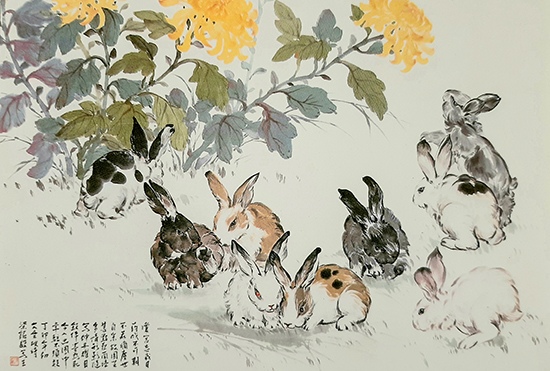
Although traditional training in Chinese paintings focuses a lot on learning from making master copies of the classics, she dared to explore creative possibilities, taking subjects from modern life, hence expanding and enriching the subject matter without sacrificing traditional emphasis on inner spiritual import.
Once she saw a grasshopper on the window frame with sunset seeping through the screen. Greatly inspired, she attempted a creative composition with daring, untraditional brushstrokes in light yellow to suggest the effect of the sunlight. That was the first time she felt thrilled to achieve a Chinese painting based on life studies in a modern situation.
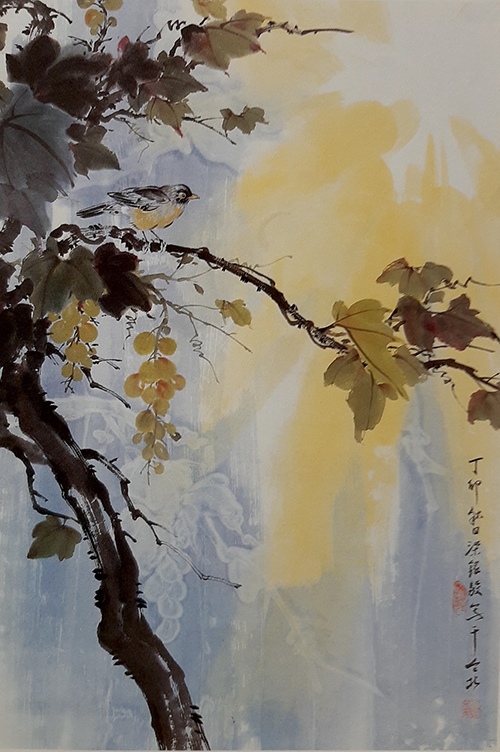
Later she tried to use large, fat brushes to “brush” in the steadfast spirit of pine trees against gusty winds. Instead of traditional branches or pavilions, she used light ink to suggest overlapping roofs behind flying swallows with a sense of modernity inspired by photography. While her father frowned at such non-traditional approaches, she was encouraged by her mother to go ahead and explore these new directions so she could find her true path with complete freedom.
Besides doing art she also wrote condensed instructions, based on her years of teaching experience, into art books such as “The Art of Pencil Drawing I & II”, “The Art of Pastel “, “Pastel Techniques“, and “Pencil Drawings: Fundamental Training”.
As a freelance writer, she has shared her reflections and experiences in several newspapers and magazines, with some published in “Traveling with Art Pencils”. Her writings, often with few words, are humble and try not to “show off”. Though her words are simple and few, they are inspiring and uplifting.
She was also often commissioned to make illustrations for World Journals and other publications. She would have to read the article, thoroughly understand the message conveyed, then transform the ideas in the article into one single image.
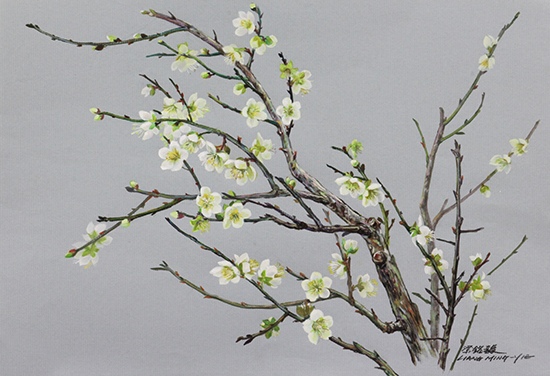
Chinese Painting and Western Painting
Compared / Contrasted
Like her grandfather and parents, Ming-Yi is versed in both Chinese and Western painting. For her, both approaches are unique in their own way with some differences on a conceptual level. In art training, both can complement each other. For example, Western drawing is the basis of all art. It helps to capture forms correctly in Chinese painting. The brushstrokes and artistic conception of Chinese art, on the other hand, can be fused into the creation of Western painting and open up new possibilities.
The linear qualities are emphasized more in Chinese painting, while the expressions of planes, masses, and the effects of light are very important in Western painting.
In Chinese painting, one can create similar spatial depth ideally expressed in a more succinct, or “less is more”, manner. One can “read” the brushstrokes that convey the personality, mood, and inner cultivation of the artists. It appreciates “reserved white” much more than does Western painting.
While using the brush Chinese painting focuses on the resolute gesture, the momentum, and the energy transmitted from mind to hand. Lots of attention is also given to the “color” or “rhythmic quality” of the ink; something abstract and “distilled” from the inner realm. If one holds a brush like holding a pencil, the energy transmission is lost.
Different cultural heritages present various kinds of beauty. Nowadays what’s common is the time we currently live in. If there are similar ideas to express, the difference only lies in the media chosen. Chinese painting can express advanced drawing skills, while the free expression and creativity of Westerners can be very impressive.
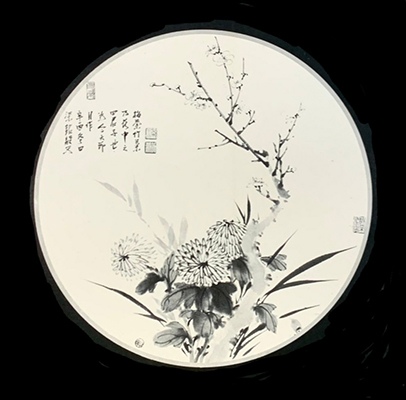
The Four Gentlemen
The “Four Gentlemen” in Chinese painting refers to plum blossoms, orchids, bamboo, and chrysanthemums.
Plum blossoms bloom while most flowers fade. Their resilience against severe cold symbolizes perseverance and integrity. Orchids grown in lost valleys are still graceful and fragrant even though perceived by no one. They symbolize sagely indifference to worldly values such as power and fame. Bamboo is straight and empty through the center, symbolizing uprightness and humbleness. In late Fall all flowers die while chrysanthemums stand alone amid frost and snow, symbolizing the steadfast, chaste quality admired by the literati and artists.
In training the novice the Four Gentlemen is the doorway to learning other subjects such as flowers, birds, and landscapes. For example, the “crossing two leaves to form a phoenix eye” and “breaking the phoenix eye” in learning to draw orchids avoids parallel lines.
Favorite Medium/Subjects
Ming-Yi thinks every medium has its unique characteristics and advantages. Even something as plain as a pencil, despite its being the simplest of all art tools, can create effects that are delicate, bold, or untrammeled. It is easily adaptable and can create textures of all kinds. One can use it for any subjects from still life, animals, landscapes, to figures. Skillful use of the pencil can also create all kinds of enchanting effects.
When she was in art school she was so rebellious that she even refused to take a look at the pencil which her mother used a lot in her art and travel. After marriage and having her own child, she picked up the pencil again. Henceforth it seemed the pencil was spellbound, propelling her rebellious mind to art. She drew day and night with a pencil like crazy while blue veins protrude up on the back of her skinny hands. With forthright freedom, her pencil drawings, unlike what came before her, reached new heights with fresh appeal based on observations of modern life.
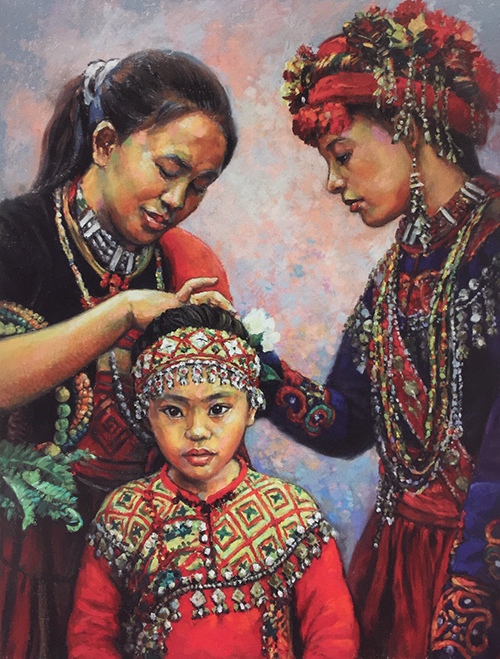
She loves pastel for its tactile feel. After her hands developed an allergic reaction to it, she started wearing gloves and tried oil pastels from Caran D’ache or Sennelier. They are wonderful for mixing; with the right paper, they create rich, chromatic effects, and are suitable for those with busy schedules because one can pick up oil pastel and draw whenever there is time and stop when necessary. Colored pencils make possible very refined textures and minute details. She also enjoys painting with watercolor, but just like Chinese brush painting, they often need to be done in one go. Therefore she would choose a particular media depending on the time available and the specific characteristics of her subject.
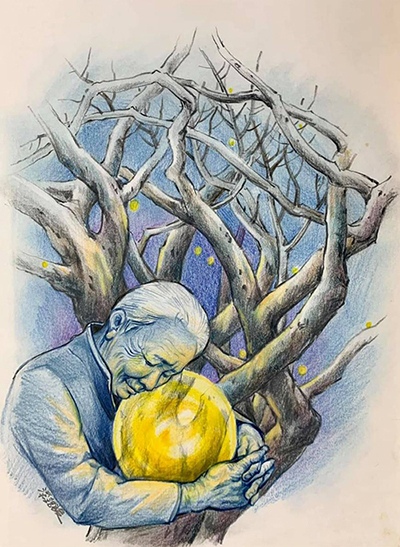
For her, one usually can see the world through art, at the same time understand oneself better.
Although sometimes she focuses on a certain theme for a while, she refuses to limit herself to just one particular subject or what’s preferred. This world around us is so vast! There are many inspiring subjects that are easily available for life studies, realistic rendering, or surreal juxtapositions. One can let go of free imagination, or experiment with mixed media… why not try everything we come upon? Why not adjust our approaches when conditions and inspirations call for it?
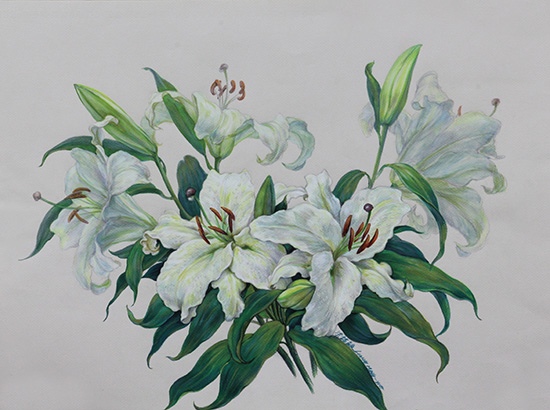
For example, in her recent focus on lilies, she experiments with metallic watercolor — something she’s never tried before. Then she finished the details with colored pencils — a mixed media approach she attempted for the first time.
On her birthday she came upon a pink toy rabbit, something she would never consider for its being too artificial. She decided, however, to think outside the box, let go of her pride and prejudice, start a watercolor, and slowly savor the taste of youthful dreams with an open mind.
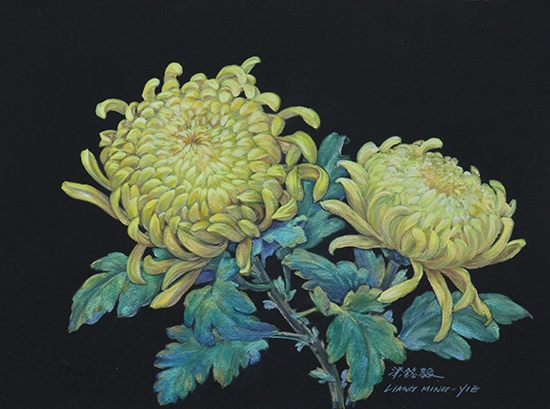
Suggestions for Art Lovers
Ming-Yi thinks it is important to build up solid skills in drawing, depth learned, distilled, and transformed from cultural heritages, and inner strength through the cultivation of the mind.
Therefore the best way to approach art is to first have command of drawing skills so as to establish a strong foundation. In America, famous for its quest for freedom, serious students studying animation, for example, had to go through very demanding courses on drawing, anatomy, perspectives, etc.
If indeed one’s skill reaches the peak, there is no end to practicing; it is very important!
While skills can be commanded by everyone, it is important to cultivate the mind, enrich it with art, history, wisdom, and inspiration from books and other cultural artifacts. Otherwise, even if one’s art excites the viewer, the moving power won’t last. Therefore, we need to invest time and effort to gain more knowledge and wisdom through never-ending study and reflection.
As an artist true to our heart, let us do art with a free spirit, sincerity, and observe carefully the beauty of things and people around us!
Footnote: parts of this article quote from “On the mother-daughter double solo shows of Dan-Fong Liang and Ming-Yi Liang” and “Companionships between mother and daughter—on the double solo shows of Dan-Fong Liang and Ming-Yi Liang”, interviews published in Women Magazine, etc. by Dian-Wan Zhang and Yi-Mei Yang
